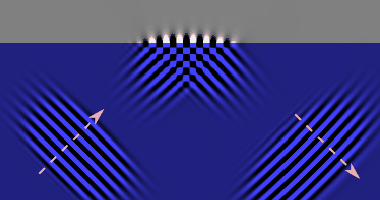I have a very simple question about incident an reflected waves. Consider for instance an incident light ray on an interface between two different materials. We know that there will be a reflected wave (with same angle of incidence) and a transmitted wave.
Let's focus on incident and reflected waves. My question is: do these waves interfere and become one single wave, or will they be separate?
I have inserted the following picture to explain better my doubt:
Consider a plane object (in red). If the reflected ray is independent from the incident ray, that surface will see that ray arriving orthogonally at it. If incident and reflected ray interfere and become one single wave, I'd say that it would propagate on a direction which is different from both directions of incident and reflected waves.
From what I know from electromagnetic waves, I'd say they would interfere (because they have the same frequencies). But if it is true, I do not understand why we usually draw two rays with specific directions for incident and reflected waves as if they were separate entities.



